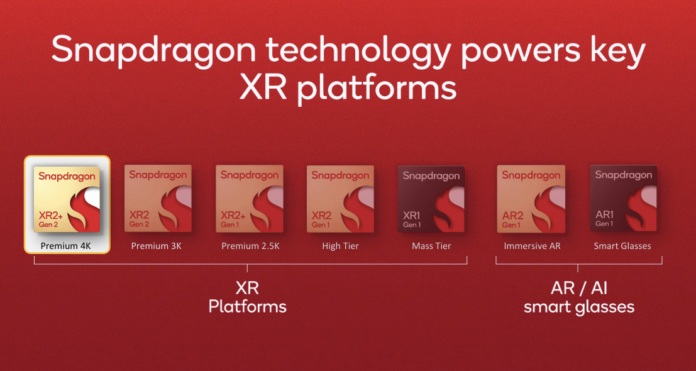The XR2+ Gen 2 comes with more GPU and AI capabilities; Qualcomm named Google and Samsung as among OEM partners
Ahead of the Consumer Electronics Show starting today in Las Vegas, Qualcomm announced the latest-and-greatest in Extended Reality (XR) silicon platforms. The XR2+ Gen 2, which iterates on the recently announced XR2 Gen 2 platform, brings increased GPU performance compared to its predecessor along with more AI horsepower and support for a 4.3K x 4.3K per eye display rendered at 90 frames per second. Of note, and acknowledging that the full specs for the Apple Vision Pro have not been made public, this is being read as Qualcomm’s go at enabling competition in the high-end virtual and mixed reality market category.
In a briefing with press and analysts ahead of CES, Qualcomm’s Said Bakadir, senior director of XR product management, said there is the “potential” to see commercial devices launched this year using the XR2+ Gen 2 but didn’t give any further details. Along with the OEM deals with Google and Samsung, Qualcomm has said other hardware partners include HTC, Play for Dream and Vive. Connectivity is delivered by Wi-Fi 7, Wi-Fi 6 and Wi-Fi 6E.
Speaking about Qualcomm’s broader XR portfolio, which also includes chipsets optimized for augmented reality (AR) and XR across different price tiers, Bakadir said the outlook for smart glasses and immersive headsets is bright. As cameras, microphones and eye movements become inputs to on-device AI capabilities, “It will change really how we perceive the world around us,” he said.
Additional upgrades with the XR2+ Gen 2 include more CPU performance and support for 12 or more concurrent cameras. The new platform supports foveated rendering wherein compute load is managed by tracking a users’ eye movements and sharpening the display where they’re looking and cutting back clarity in the periphery. And as it typically does, Qualcomm also announced a reference design using the new chipset that developed by Goertek with eye tracking technology from Tobii.
In a statement Qualcomm VP and GM of XR Hugo Swart said the new platform and its enhanced resolution “will take XR productivity and entertainment to the next level by bringing spectacularly clear visuals to use cases such as room-scale screens, life-size overlays and virtual desktops. We are advancing our commitment to power the best XR devices and experiences that will supercharge our immersive future.”
Back to the comparison with the Apple Vision Pro which is expected to have a price tag of $3,499 and hits shelves in the U.S. on Feb. 2, Bakadir was careful to say device pricing is up to the OEM and is typically the result of compromising some performance component for its associated cost. That said, he said the XR2+ Gen 2 was capable of delivering premium consumer-grade experiences “way below” that $3,000-plus level.
Looking at the whole portfolio, for VR/MR platforms Qualcomm has the Snapdragon XR2 Gen 2 which supports 3K resolution and the XR2+ Gen 1 which supports 2.5K resolution in its premium tier. The high tier is served by the XR2 Gen 1 and the mass market tier by the XR1 Gen 1. For AR glasses, Qualcomm has in market the AR1 Gen 1 and AR2 Gen 2.
Writing in a research note, XR expert and Moor Insights and Strategy VP and Principal Analyst Anshel Sag laid out the competitive dynamic and where Qualcomm’s latest fits. “As everyone anticipates the Vision Pro and its high-resolution displays, Qualcomm is poised to enable the whole ecosystem to compete with Apple using its latest XR platforms…While the XR2+ Gen 2 is a considerable improvement on the XR2 Gen 2, it is pretty clear that this launch needs to be seen in the context of what is happening more broadly within the industry. The XR2+ Gen 2 will be at the core of what Samsung and Google use to compete with Apple in XR.”

